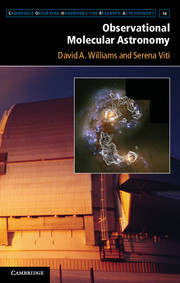Book contents
- Frontmatter
- Contents
- List of Illustrations
- List of Tables
- Preface
- 1 Introduction
- 2 Spectra and Excitation of Interstellar Molecules
- 3 Astrochemical Processes
- 4 Physical Processes in Different Astronomical Environments
- 5 Molecular Tracers in the Milky Way Galaxy
- 6 Molecular Tracers in External Galaxies
- 7 The Early Universe and the First Galaxies
- 8 Recipes for Molecular Submillimetre Astronomy
- 9 Chemical and Radiative Transfer Models
- 10 Observations: Which Molecule, Which Transition?
- Appendix: Acronyms
- Index
- References
2 - Spectra and Excitation of Interstellar Molecules
Published online by Cambridge University Press: 05 December 2013
- Frontmatter
- Contents
- List of Illustrations
- List of Tables
- Preface
- 1 Introduction
- 2 Spectra and Excitation of Interstellar Molecules
- 3 Astrochemical Processes
- 4 Physical Processes in Different Astronomical Environments
- 5 Molecular Tracers in the Milky Way Galaxy
- 6 Molecular Tracers in External Galaxies
- 7 The Early Universe and the First Galaxies
- 8 Recipes for Molecular Submillimetre Astronomy
- 9 Chemical and Radiative Transfer Models
- 10 Observations: Which Molecule, Which Transition?
- Appendix: Acronyms
- Index
- References
Summary
In this chapter we summarise briefly the notation of molecular spectroscopy, with examples of transitions used to identify molecular species in the interstellar medium. We also describe how radiation is transported in the interstellar medium, introducing ideas that will be needed in Chapters 8 and 9. Finally, we discuss the processes that determine level populations of molecules in the interstellar medium.
Molecular Spectroscopy
Whereas most atomic spectra are determined simply by transitions between individual electronic states, molecular spectra are more complex because molecules have additional degrees of freedom associated with vibration and rotation. Each electronic state of a molecule possesses a manifold of vibrational levels, and each of those vibrational levels has a ladder of rotational levels associated with it. Electronic transitions in molecules therefore occur between specific vibrational and specific rotational levels in each electronic state. The equivalent of a single atomic line corresponding to an electronic transition is – for a molecule – replaced by a set of many lines (see Figure 1.2 for part of the H2 electronic transition B–X, between the two lowest electronic states, showing the vibrational and rotational structure). These electronic transitions often lie in the ultraviolet spectrum.
Molecules also possess transitions that have no counterpart in atoms. Molecules may undergo transitions between specific rotational states of vibrational states, that is, ro-vibrational transitions. These transitions usually occur in the near-infrared range. Pure rotational transitions may also occur between rotational states of the same vibrational level. These tend to lie in the far-infrared, or in the millimetre to submillimetre range of the electromagnetic spectrum.
- Type
- Chapter
- Information
- Observational Molecular AstronomyExploring the Universe Using Molecular Line Emissions, pp. 16 - 23Publisher: Cambridge University PressPrint publication year: 2013



